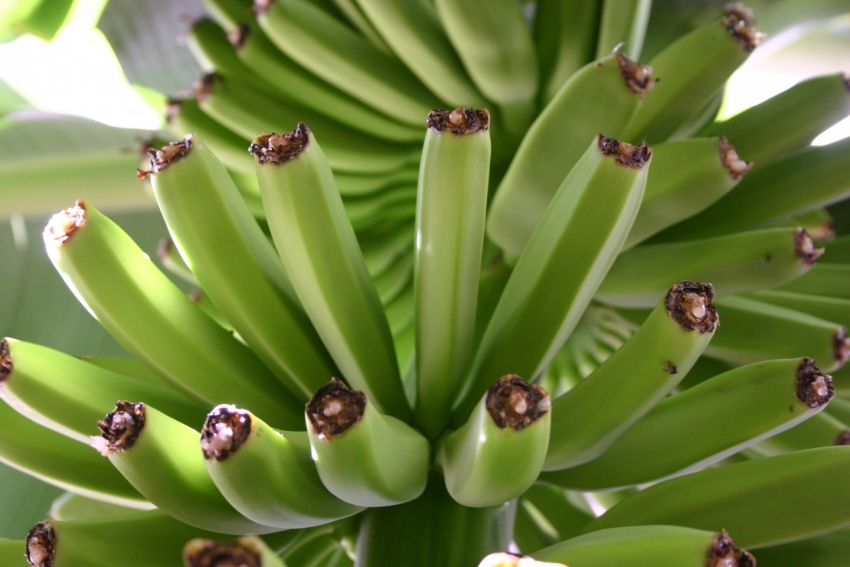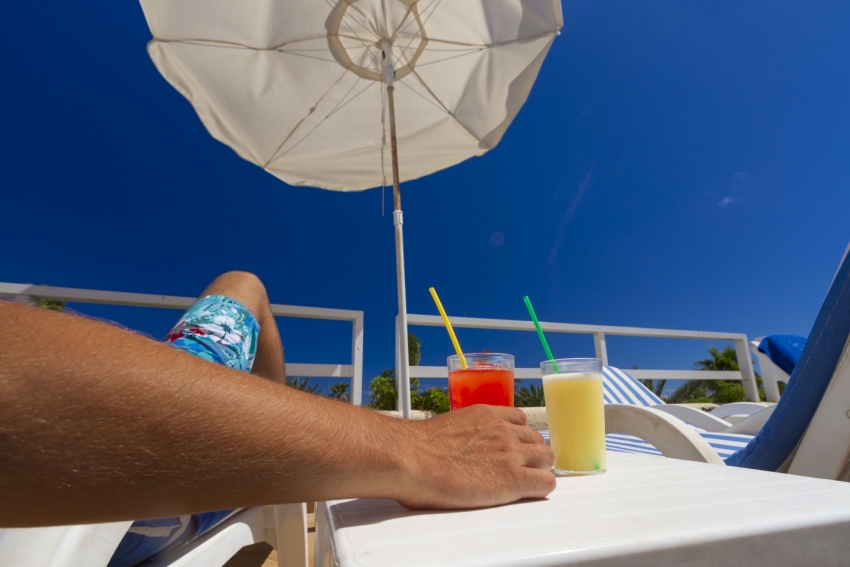Mango
The king of fruits: Mangoes are originally from India but grow well at low altitudes in Gran Canaria and are in season from late summer until the winter.
Canarians distinguish between mangos, which are small, intensely flavoured but with stringy flesh, and mangas, which are larger with no fibres but sometimes less tasty.
Mangos can be green, yellow, orange or red when ripe, but all types soften when ready to eat.
Alex says: If you can smell a mango, then it tastes good but not all tasty mangoes smell.
All mangos are rich in Vitamin C and Folate (Vit B9).
Mangos cost between 2 and 6 euros per kilo in Gran Canaria depending on the season.
Pineapple / Piña tropical
Pineapples grow well in north Gran Canaria around Galdar and Agaete, but most of the ones you see are from El Hierro island; it grows 1.5 million kilos of pineapple a year.
Lex says: Test a pineapple's ripeness by tugging one of the leaves on top. If it comes off easily, then the fruit is ripe. To get a tasty one, pick a fruit that you can smell across the room.
Local pineapple's are on sale all year round in Gran Canaria and it's currently illegal to sell imported pineapples in the Canary Islands.
Pineapple's are rich in Manganese and Vitamin C.
A fresh pineapple in Gran Canaria costs between three and five euros depending on size.
Banana / Platano
The dwarf Cavendish bananas grown in Gran Canaria produce small, sweet fruit that ripen with little black marks on the skin. This puts some people off but who cares: It means that there's plenty for everyone else.
Banana plantations cover large areas of north Gran Canaria, but they grow all over the island.
Buy bananas in Gran Canaria from local fruit shops or from markets rather than from supermarkets. You'll get fruit that spent longer ripening in the sun and is, therefore, sweeter and tastier.
Bananas are rich in Vitamin B6, manganese, Vitamin C and potassium.
Alex says: To ripen bananas fast, put them in a paper bag.
A kilo of bananas in Gran Canaria costs about a euro.
Custard Apple / Cherimoya
Mark Twain called the cherimoya "the most delicious fruit known to men".
About the size of an apple with knobbly, green skin cherimoyas have rich, white flesh that tastes a bit like bubble gum, with hints of banana and pineapple. Even rock hard ones soften within a few days.
To eat a ripe cherimoya leave it in the fridge until cold. Cut in half and scoop out the creamy white flesh with a spoon. Don’t crunch up the big seeds as they taste horrible and are poisonous.
Cherimoyas cost about three euros a kilo in Gran Canaria. They are packed with Vitamin C.
Guava / Guayaba
With a cloying smell that reminds some people of cat pee and lots of hard pips in the centre, guayabas aren't welcome in lots of fruit bowls. It's a shame because they are sweet with a taste half way between a pear and a strawberry.
Guayabas are pretty variable in Gran Canaria: The peel can be green or yellow and the flesh and seeds pink or white. Occasionally you find tiny, red-skinned strawberry guavas (there's a tree in the Huerto de las Flores in Agaete).
Guavas are ripe when they are slightly soft to the touch and start to smell. Guayaba skin is edible, but most people peel them (use a speed peeler). Use guavas in a fruit salad or just eat whole.
Guayabas are rich in Vitamin C
Guavas sell for about a euro a kilo in Gran Canaria shops and markets.
Avocado / Aguacate
Apart from a short spell at the end of summer, there are avocados in the shops and markets in Gran Canaria all year round. The best are the Hass variety with wrinkled green or black skin and creamy flesh.
Choose avocados that look plump and are slightly soft to the touch. To ripen hard ones put them in a paper bag or under a cloth with a ripe banana.
Avocados cost between two and seven euros per kilo in Gran Canaria shops, depending on the season.
Alex says: Cut a ripe avocado in half, remove the pip and put Worcestershire sauce in the hole. Delicious.
Cactus fruit / Tuno
Tunos grow wild all over Gran Canaria, but we recommend buying them rather than picking them because they are covered in tiny spines that have to be cleaned off.
Two main types appear in Gran Canaria shops and markets. Small tuno indio with red skin and deep red flesh, and tunos that can be green, yellow, orange or red. Tuno indio are acidic and used in smoothies while tunos taste like sweet cucumber and are delicious straight out of the fridge. Just chew the flesh and swallow the little pips.
To prepare a tuno, cut off both ends, slit the skin vertically and then peel it back. Don't let the fruit touch the outside of the skin as there's always a couple of spines left.
Tunos are rich in Vitamin C and full of fibre.
They sell for about two euros per kilo in shops and markets.
Loquat / Nispero
Nisperos or loquats are small, orange fruit with thick skin and large brown pips. They grow in little bunches and look like a cross between an apricot and a pear. Tangy and juicy, nisperos taste like an apricot with a floral hint. Don't eat the pips or the skin.
Nisperos are full of Vitamin A.
We've seen nisperos on sale in the UK for a pound each, but they cost about two euros per kilo in Gran Canaria shops and markets. They are in season in late spring and early summer.
Pawpaw / Papaya
Papayas or pawpaws in Gran Canaria vary from little things that fit in your hand to huge, head-sized fruit. All have yellow skin and lots of little black pips in the middle. The soft flesh can be yellow, orange or pink.
In Gran Canaria, small pink-fleshed papayas are called papayos while bigger, yellow and orange-fleshed ones are called papayas. Papayos tend to be sweeter.
Choosing a good papaya is tricky as the flavour only develops when they are completely ripe and soft. Look for fruit with little soft patches and a slight odour of petrol, or ask for "papaya para hoy". If you buy a hard papaya, leave it in a paper bag on a warm windowsill until it softens.
Peel your papaya with a speed peeler and mix with sugar and lime juice for a fantastic dessert (a glug of sweet sherry or port also goes well).
Papayas are full of Vitamin C and Folic Acid and sell for about two euros per kilo in Gran Canaria shops and markets.
Lex says: slices of papayo are often served in a classic Puerto de las Nieves mixed salad.
Barbados Cherry / Pitanga
The pitanga or Surinam cherry is a small ribbed fruit that can be red or a deep maroon when ripe. It's rarely sold in shops because the fruit is soft when ripe. However, pitanga trees grow in gardens and even wild in Gran Canaria.
Pitanga fruits are sweet and sour with a slightly resinous flavour. You eat the whole fruit but watch out for the stone. They are full of Vitamin C and also contain Vitamin A.
You won't find pitangas in the shops because they are too delicate but do try them if you find a tree.
Alex says: The best place to find pitangas is over the door of the Huerto de las Flores garden in Agaete.














